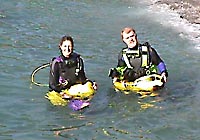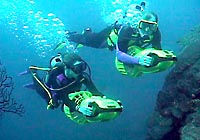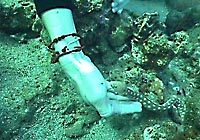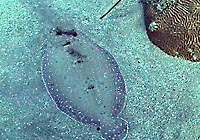 |
|||||||||||||||||||||||||
Hi everyone! My name is Tracy Baynes and I am a coral reef ecologist. I am excited to be joining Wayne and Karen in their exploration of the reefs of St. Lucia. It is my first morning on the island and I am ready to hit the water! Wayne and I suit up in our scuba equipment and grab two underwater scooters. The scooters have little propellers that spin, and by holding on to them, we can catch a ride underwater! What an amazing experience! Because the water is so clear, it feels like you are flying above the reef. Wayne and I decide to start deep, so we head down to a depth of 80 feet along the reef wall. Covering the wall are many different species of corals, sea fans, sponges, and crinoids. Crinoids are strange-looking animals. They are also known as feather stars because each of their many (up to 100) arms looks like a feather. Crinoids are in the same group of animals as starfish, but they look very different. Feather stars are filter feeders. They hold their arms up in the current and gather small floating plants and animals (plankton) with their sticky feather-like tentacles. We cruise slowly up along the wall past azure vase sponges (with a gorgeous light blue/purple color), brain coral (which really do look like a brain!), fireworms (don't touch-they'll leave poisonous hairs in your finger), fire coral (you guessed it, fire means don't touch), long trumpetfish (which actually look more like a flute), and even longer sea whips (a soft coral that can grow to be eight feet long). We also see an impressive variety of corals with names such as star coral, finger coral, or golfball coral, honeycomb plate coral, lettuce coral, cactus coral, artichoke coral, mushroom coral and flower coral (you can imagine the variety of shapes, sizes and colors of these corals!). Imagine you are a sea creature living here. In a world where every creature is looking for their next meal, and someone who's bigger and hungrier than you might be lurking just around the corner, it's important to have a way to defend yourself. One way is to make yourself big and spiny. That's the strategy used by the long-spine sea urchin. No fish wants to get a mouth full of sharp spines! It is good to see the long-spine sea urchin on this reef. There was a large die-off of this urchin throughout the Caribbean in the early 1980s due to a disease. Their comeback is good news for Caribbean reefs. Urchins eat algae and open up space for both old and new corals to grow. Another strategy for keeping away from hungry mouths is to hide inside holes and cracks in the reef. This is where you would expect to find a sharptail eel during the day. Wayne and I are pleasantly surprised, however, when we come across one slithering over the reef surface. Another place to hide is under the sand. That's where the peacock flounder we see later in our dive typically hides. Flounders are very flat fish and have both of their eyes on the upper side of their body! This way they can lie hidden in the sand and still see what's going on around them. Unfortunately for Wayne and I, we are not as well adapted as reef creatures for life underwater. After a long and fascinating day on the reef, we head for shore. As I walk out of the surf, I am already anticipating our next dive and the discoveries that lay ahead. |
Wayne and Dr. Baynes geared up and ready to go to check out Anse Chastanet Reef on their underwater scooters.
Wayne and Dr. Baynes use underwater scooters to survey the deep reef wall.
Dr. Baynes examines a golden crinoid (feather star). Tiny tube feet lining the arms of the feather star cling to her fingers. Nice grip!
Wayne and Dr. Baynes check out a long-spine sea urchin. In order to pick up this spiny creature, Wayne digs his hand under the sand to reach the blunter spines on the underside of the urchin.
IDr. Baynes lets a friendly sharptail eel swim across her hand.
A peacock flounder is well camouflaged and hidden when it buries itself under the sand. Its two eyes are slightly raised above the rest of its body so that it can still see when buried in the sand. |
||||||||||||||||||||||||
home | basecamp | archives | other expeditions | kids' page | contact us © 2001, The Ocean Adventure All rights reserved. |





